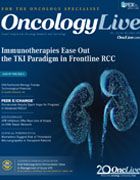Ivosidenib Holds Greatest Benefit for Older Patients With IDH1-Mutant AML
Courtney D. DiNardo, MD, MSCE, discusses the findings of the phase I dose-escalating study that led to the initial approval of ivosidenib for adult patients with relapsed or refractory acute myeloid leukemia with an IDH1 mutation.
Courtney D. DiNardo, MD
Ivosidenib (Tibsovo) is changing the treatment landscape for adult patients with relapsed or refractory acute myeloid leukemia (AML) with an IDH1 mutation. The FDA approved ivosidenib in July 2018 to treat this patient population.
In February 2019, Agios Pharmaceuticals, Inc, the manufacturer of the drug, reported that the FDA had granted a priority review to a supplemental new drug application to expand the use of ivosidenib to the frontline setting for patients with IDH1-mutant AML who are ineligible for standard chemotherapy. Then, in March 2019, ivosidenib received a breakthrough therapy designation from the FDA in combination with azacitidine for the treatment of patients with newly diagnosed IDH1-mutant AML who are ≥75 years old or ineligible for intensive induction chemotherapy.
In an interview with OncologyLive®, Courtney D. DiNardo, MD, MSCE, discussed the findings of the phase I dose-escalating study that led to the initial approval of the drug. DiNardo is an associate professor in the Department of Leukemia at The University of Texas MD Anderson Cancer Center in Houston and lead author of the study findings published in the New England Journal of Medicine.1
What proportion of patients with AML are eligible to receive this therapy?
IDH1 mutations occur in approximately 8% of patients with AML. These mutations are rare in children and young adults but have increasing incidence with older age so that patients over age 60 have a roughly 15% incidence. IDH1 mutations also occur in patients with MDS [myelodysplastic syndromes] or myeloproliferative neoplasms like myelofibrosis, particularly at the time of progression or transformation to AML. The increasing incidence of IDH1 mutations with age is important, as ivosidenib offers a well-tolerated effective therapy for patients who have difficulty tolerating standard intensive therapies.
Could you please put this new therapy into perspective for patients with AML? How much of a difference does it make in the treatment paradigm?
In patients with relapsed or refractory AML with an IDH1 mutation, ivosidenib leads to a clinical response in over 40% of treated patients, including 25% experiencing a true CR [complete remission] with full count recovery. This is significant, especially considering that treatment leads to clinically meaningful responses without myelosuppression or myelosuppression-related [adverse] effects. Responding patients typically have durable responses as well, with patients attaining a CR or CRh [CR with partial hematologic recovery] experiencing a median OS [overall survival] of over 18 months. [The median OS in the primary efficacy population was 8.8 months (95% CI, 6.7 to 10.2).]
Which patients are ideal candidates for this therapy?
Any patient with an IDH1 R132 mutation is eligible and appropriate for ivosidenib. The mutational burden (ie, the mutant IDH1 variant allelic frequency) is not predictive of response or resistance to therapy.
Please comment specifically about differentiation syndrome and QTc interval prolongation.
Because ivosidenib works through differentiation and maturation of the abnormal leukemic clone, differentiation syndrome can be an important clinical event during treatment. Because the signs and symptoms of differentiation syndrome [DS] are nonspecific—including pleural infiltrates, effusions, shortness of breath, edema, weight gain, and culture-negative fevers—the provider must have an index of suspicion to identify DS or else it can be considered an [adverse] effect of leukemia or infection.
DS can occur at any time; typically 2 to 6 weeks into therapy. Dexamethasone 10 mg [twice daily], which is the same treatment used for DS related to ATRA [all-trans retinoic acid] and/or ATO [arsenic trioxide] use in patients with APL [acute promyelocytic leukemia], is very effective when used in a timely fashion.
There is a signal of QTc prolongation with ivosidenib. Any-grade QTc prolongation occurred in about 25% of patients treated, and grade >3 QTc prolongation occurred in about 10% of patients in the original phase I [study].
Notably, QTc-prolonging medications such as azoles, fluoroquinolones, and antiemetics were all allowed on the study and, in my experience, the QTc prolongation appeared mostly as a cumulative interaction. Often holding or transitioning the other QTc offenders was all that was necessary to resolve the issue. Certainly, in persistent QTc elevation, ivosidenib dose reduction is warranted; this was required in 2 patients in the phase I study.
Is there anything noteworthy or unusual about the administration of this therapy?
This is a well-tolerated daily oral outpatient therapy.
Could you please comment about potential frontline indications for ivosidenib?
The combination of ivosidenib and azacitidine looks to be very effective in the early available clinical data for newly diagnosed, older, and “unfit” patients with AML. In the 23 patients treated on this combination, the overall response was 78%, with a true CR rate of 57% and a median duration of response that has not yet been reached.2
How would this change the landscape for this patient population?
There is a patient population of newly diagnosed older and unfit AML patients, particularly those with a history of MDS treated with hypomethylating agents, that would be appropriate for ivosidenib as frontline therapy if the IDH1 mutation was detected. This could be a very effective and well-tolerated treatment choice.
References
- DiNardo CD, Stein EM, de Botton S, et al. Durable remissions with ivosidenib in IDH1-mutated relapsed or refractory AML. N Engl J Med. 2018;378(25):2386-2398. doi: 10.1056/NEJMoa1716984.
- Agios receives FDA breakthrough therapy designation for TIBSOVO (ivosidenib) in combination with azacitidine for the treatment of newly diagnosed acute myeloid leukemia (AML) with an IDH1 mutation in adult patients ineligible for intensive chemotherapy [news release]. Cambridge, MA: Agios Pharmaceuticals, Inc; March 26, 2019. agiospharmaceuticalsinc.gcs-web.com/node/12311. Accessed March 27, 2019.




